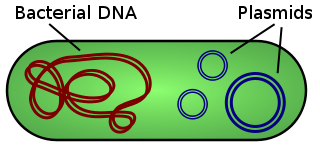Plasmid as a vector
Image courtesy: http://upload.wikimedia.org/wikipedia/commons/thumb/c/cf/Plasmid_%28english%29.svg/320px-Plasmid_%28english%29.svg.png
Plasmid
In the early 1970s a number of natural plasmids were artificially modified and constructed as cloning vectors. It is an extra-chromosomal DNA which is circular and is autonomously replicating double stranded DNA present in addition to DNA.The size of plasmids ranges from a few kb to near 100 kb. They can hold up to 10 kb fragments. They carry can carry antibiotic resistance genes, genes for receptors, toxins or other proteins. These genes of a particular type can be used as a selectable marker to ensurethat bacteria in a culture contains a particular plasmid. Plasmids can be engineered to be useful cloning vector.
There are few types of plasmid:
Resistance (R) plasmids : The plasmids that have resistance against antibiotics and poisons
Eg- RP4 of Pseudomonas
Fertility (F) plasmids: Those which contain tra genes and are capable of conjugation.
Eg- F plasmid of E.coli
Col plasmids: contain gene that produce toxins that can kill other bacteria
Eg: Col E1 of E.coli
Cryptic plasmid: plasmids whose phenotypic trates are known but not the function. They occur in a number of bacterial species.
Degradative plasmid: Allows the host bacterium to metabolize unsuual molecules such as toluene an salicylic acid.
Eg: TOL of Pseudomonas putida
Classification:
It can be classified into tow major types conjugative and non-conjugative based on whether they carry tra gene or not.
- Conjugative: high molecular weight and have one to three copies per cell.
- Non conjugative: Low molecular weight and have multiple copies per cell.
Plasmid copy number
Incompatibility of plasmids
It is the inability of two different plasmids to coexist in the same cell in absence of selective pressure.[3] Groups of plasmid which are mutually incompatible are said to belong in the same incompatibility group. Plasmid are said to be in compatible if they have same replicative mechanism.
Properties of plasmid cloning vector
- Low molecular weight
- Ability to confer readily selectable phenotypic traits on host cells
- Single site for large number of restriction enzymes
- Contain a genetic marker (usually dominant) for selection.
- Minimum amount of nonessential DNA to optimize cloning.
The selective marker is a specific DNA sequence that is used by biologists to tell if the clone has entered the cell, and they are usually genes that confer antibiotic resistance to the cell.[8] Usually it is a gene for resistance to an antibiotic like ampR gene for ampicillin resistance or tetR for tetracycline resistance.Most cloning plasmids will contain two markers:
The video to show how this is carried out:
- Principles of gene manupulations,S.B. Primrose, R.M.Twyman and R.W.Old, sixth edition, blackwell science.2004
- iGenetics - a molecular approch, Peter J. Russell, second edition, pearson benjamin cummings, 2006
- http://upload.wikimedia.org/wikipedia/commons/thumb/c/cf/Plasmid_%28english%29.svg/320px-Plasmid_%28english%29.svg.png
